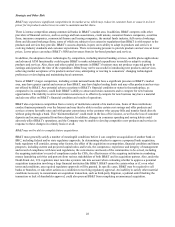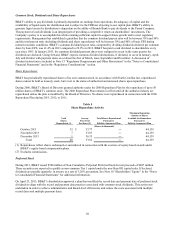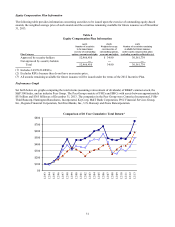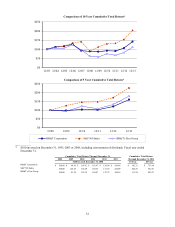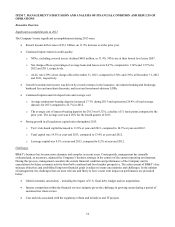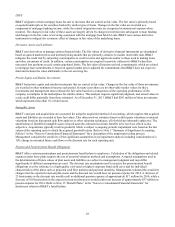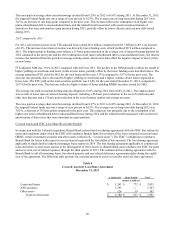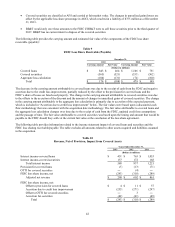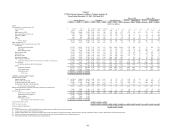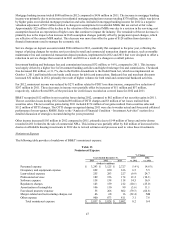BB&T 2013 Annual Report Download - page 38
Download and view the complete annual report
Please find page 38 of the 2013 BB&T annual report below. You can navigate through the pages in the report by either clicking on the pages listed below, or by using the keyword search tool below to find specific information within the annual report.
38
LHFS
BB&T originates certain mortgage loans for sale to investors that are carried at fair value. The fair value is primarily based
on quoted market prices for securities backed by similar types of loans. Changes in the fair value are recorded as a
component of mortgage banking income, while the related origination costs are recognized in noninterest expense when
incurred. The changes in fair value of these assets are largely driven by changes in interest rates subsequent to loan funding
and changes in the fair value of servicing associated with the mortgage loan held for sale. BB&T uses various derivative
instruments to mitigate the economic effect of changes in fair value of the underlying loans.
Derivative Assets and Liabilities
BB&T uses derivatives to manage various financial risks. The fair values of derivative financial instruments are determined
based on quoted market prices and internal pricing models that are primarily sensitive to market observable data. BB&T
mitigates the credit risk by subjecting counterparties to credit reviews and approvals similar to those used in making loans
and other extensions of credit. In addition, certain counterparties are required to provide collateral to BB&T when their
unsecured loss positions exceed certain negotiated limits. The fair value of interest rate lock commitments, which are related
to mortgage loan commitments, is based on quoted market prices adjusted for commitments that BB&T does not expect to
fund and includes the value attributable to the net servicing fee.
Private Equity and Similar Investments
BB&T has private equity and similar investments that are carried at fair value. Changes in the fair value of these investments
are recorded in other noninterest income each period. In many cases there are no observable market values for these
investments and management must estimate the fair value based on a comparison of the operating performance of the
company to multiples in the marketplace for similar entities. This analysis requires significant judgment, and actual values in
a sale could differ materially from those estimated. As of December 31, 2013, BB&T had $291 million of these investments,
which represented less than 1% of total assets.
Intangible Assets
BB&T’s mergers and acquisitions are accounted for using the acquisition method of accounting, which requires that acquired
assets and liabilities are recorded at their fair values. This often involves estimates based on third party valuations or internal
valuations based on discounted cash flow analyses or other valuation techniques, all of which are inherently subjective. The
amortization of identified intangible assets is based upon the estimated economic benefits to be received, which is also
subjective. Acquisitions typically result in goodwill, which is subject to ongoing periodic impairment tests based on the fair
values of the reporting units to which the acquired goodwill relates. Refer to Note 1 “Summary of Significant Accounting
Policies” in the “Notes to Consolidated Financial Statements” for a description of the impairment testing process.
Management considers the sensitivity of the significant assumptions in its impairment analysis including consideration of a
10% change in estimated future cash flows or the discount rate for each reporting unit.
Pension and Postretirement Benefit Obligations
BB&T offers various pension plans and postretirement benefit plans to employees. Calculation of the obligations and related
expenses under these plans requires the use of actuarial valuation methods and assumptions. Actuarial assumptions used in
the determination of future values of plan assets and liabilities are subject to management judgment and may differ
significantly if different assumptions are used. The discount rate assumption used to measure the postretirement benefit
obligations is set by reference to a high-quality (AA-rated or higher) corporate bond yield curve and the individual
characteristics of the plans such as projected cash flow patterns and payment durations. Management evaluated the sensitivity
changes that the expected return on plan assets and the discount rate would have on pension expense for 2014. A decrease of
25 basis points in the discount rate would result in additional pension expense of approximately $17 million for 2014, while a
decrease of 100 basis points in the expected return on plan assets would result in an increase of approximately $37 million in
pension expense for 2014. Refer to Note 13 “Benefit Plans” in the “Notes to Consolidated Financial Statements” for
disclosures related to BB&T’s benefit plans.


